cooling SUZUKI FORENZA 2008 1.G Owners Manual
[x] Cancel search | Manufacturer: SUZUKI, Model Year: 2008, Model line: FORENZA, Model: SUZUKI FORENZA 2008 1.GPages: 226, PDF Size: 5.25 MB
Page 7 of 226
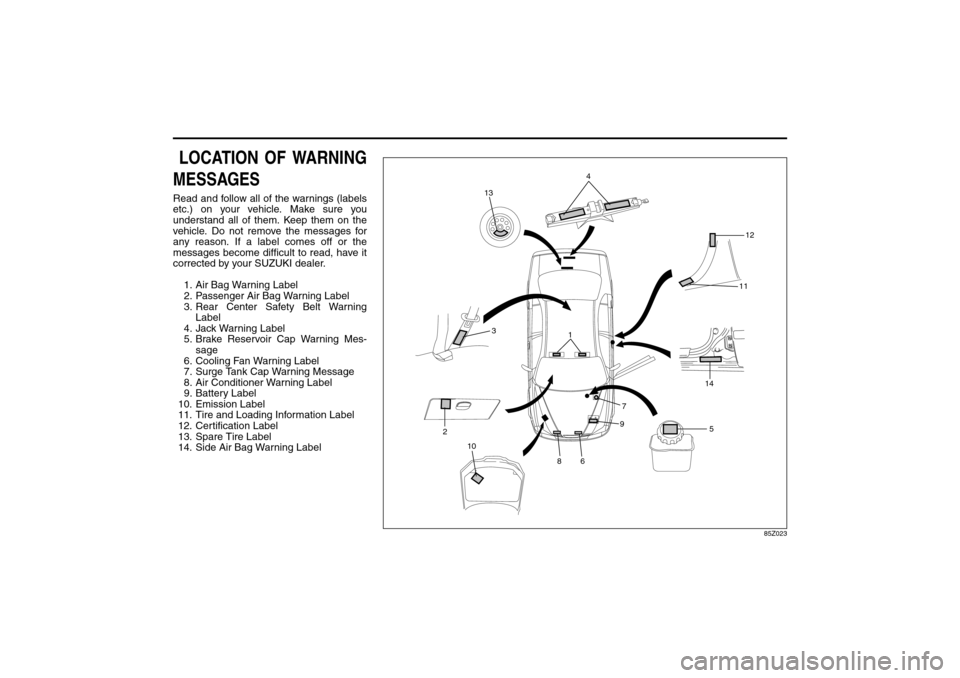
85Z04-03E
LOCATION OF WARNING
MESSAGESRead and follow all of the warnings (labels
etc.) on your vehicle. Make sure you
understand all of them. Keep them on the
vehicle. Do not remove the messages for
any reason. If a label comes off or the
messages become difficult to read, have it
corrected by your SUZUKI dealer.
1. Air Bag Warning Label
2. Passenger Air Bag Warning Label
3. Rear Center Safety Belt Warning
Label
4. Jack Warning Label
5. Brake Reservoir Cap Warning Mes-
sage
6. Cooling Fan Warning Label
7. Surge Tank Cap Warning Message
8. Air Conditioner Warning Label
9. Battery Label
10. Emission Label
11. Tire and Loading Information Label
12. Certification Label
13. Spare Tire Label
14. Side Air Bag Warning Label
85Z023
1
9
6
13
7
4
5
2
10
8
3
1112
14
Page 55 of 226
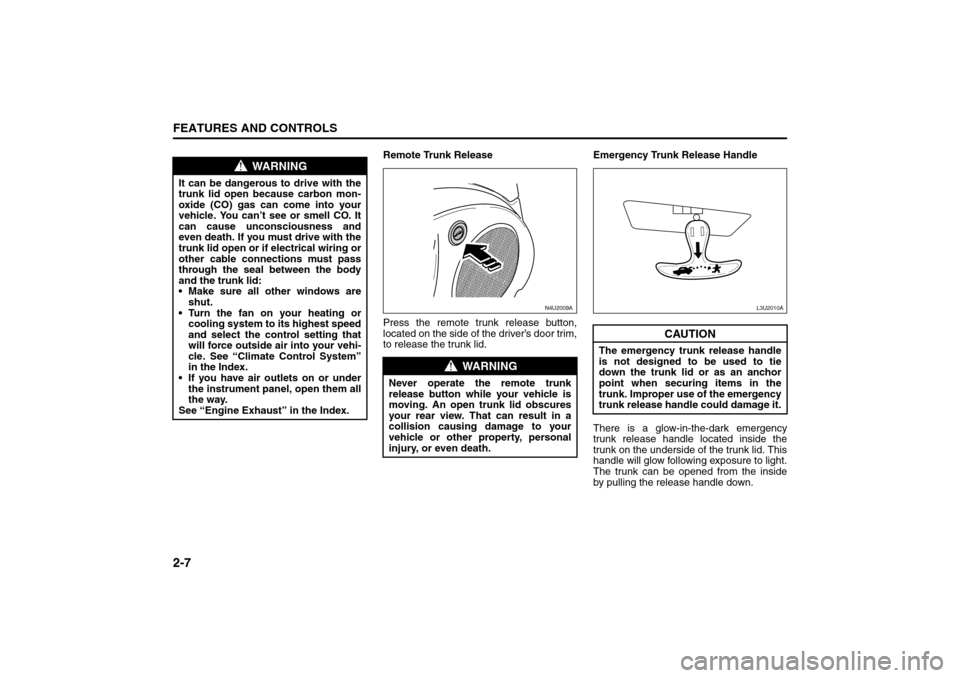
2-7FEATURES AND CONTROLS
85Z04-03E
Remote Trunk Release
Press the remote trunk release button,
located on the side of the driver’s door trim,
to release the trunk lid.Emergency Trunk Release Handle
There is a glow-in-the-dark emergency
trunk release handle located inside the
trunk on the underside of the trunk lid. This
handle will glow following exposure to light.
The trunk can be opened from the inside
by pulling the release handle down.
WARNING
It can be dangerous to drive with the
trunk lid open because carbon mon-
oxide (CO) gas can come into your
vehicle. You can’t see or smell CO. It
can cause unconsciousness and
even death. If you must drive with the
trunk lid open or if electrical wiring or
other cable connections must pass
through the seal between the body
and the trunk lid:
Make sure all other windows are
shut.
Turn the fan on your heating or
cooling system to its highest speed
and select the control setting that
will force outside air into your vehi-
cle. See “Climate Control System”
in the Index.
If you have air outlets on or under
the instrument panel, open them all
the way.
See “Engine Exhaust” in the Index.
WARNING
Never operate the remote trunk
release button while your vehicle is
moving. An open trunk lid obscures
your rear view. That can result in a
collision causing damage to your
vehicle or other property, personal
injury, or even death.
N4U2009A
CAUTION
The emergency trunk release handle
is not designed to be used to tie
down the trunk lid or as an anchor
point when securing items in the
trunk. Improper use of the emergency
trunk release handle could damage it.
L3U2010A
Doors and Locks:
Page 56 of 226
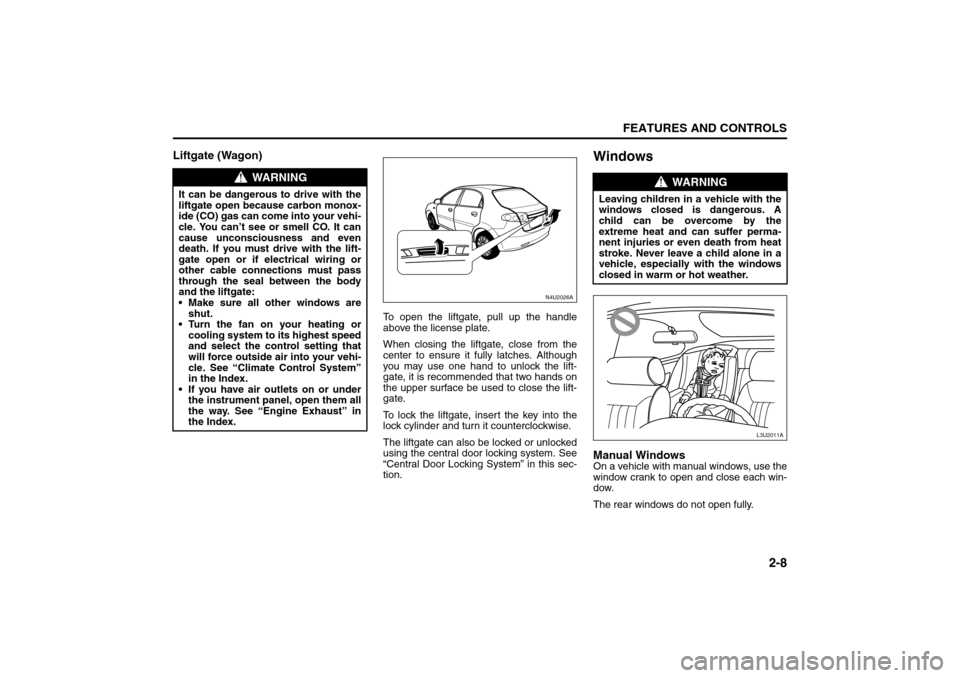
2-8
FEATURES AND CONTROLS
85Z04-03E
Liftgate (Wagon)
To open the liftgate, pull up the handle
above the license plate.
When closing the liftgate, close from the
center to ensure it fully latches. Although
you may use one hand to unlock the lift-
gate, it is recommended that two hands on
the upper surface be used to close the lift-
gate.
To lock the liftgate, insert the key into the
lock cylinder and turn it counterclockwise.
The liftgate can also be locked or unlocked
using the central door locking system. See
“Central Door Locking System” in this sec-
tion.
WindowsManual WindowsOn a vehicle with manual windows, use the
window crank to open and close each win-
dow.
The rear windows do not open fully.
WARNING
It can be dangerous to drive with the
liftgate open because carbon monox-
ide (CO) gas can come into your vehi-
cle. You can’t see or smell CO. It can
cause unconsciousness and even
death. If you must drive with the lift-
gate open or if electrical wiring or
other cable connections must pass
through the seal between the body
and the liftgate:
Make sure all other windows are
shut.
Turn the fan on your heating or
cooling system to its highest speed
and select the control setting that
will force outside air into your vehi-
cle. See “Climate Control System”
in the Index.
If you have air outlets on or under
the instrument panel, open them all
the way. See “Engine Exhaust” in
the Index.
N4U2026A
WARNING
Leaving children in a vehicle with the
windows closed is dangerous. A
child can be overcome by the
extreme heat and can suffer perma-
nent injuries or even death from heat
stroke. Never leave a child alone in a
vehicle, especially with the windows
closed in warm or hot weather.
L3U2011A
Doors and Locks:
Windows:
Page 89 of 226
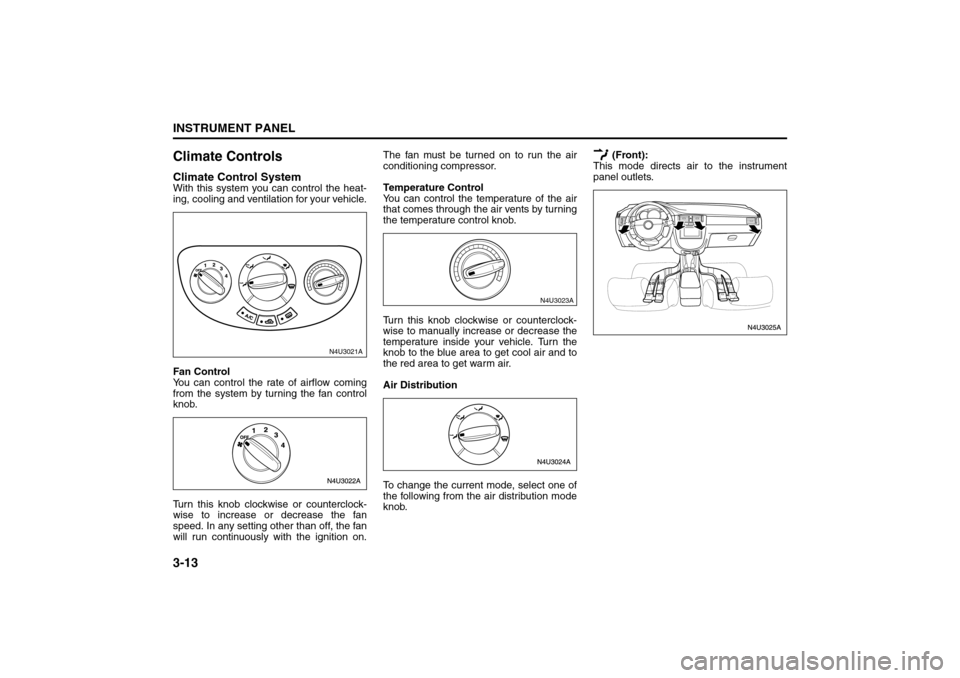
3-13INSTRUMENT PANEL
85Z04-03E
Climate ControlsClimate Control SystemWith this system you can control the heat-
ing, cooling and ventilation for your vehicle.
Fan Control
You can control the rate of airflow coming
from the system by turning the fan control
knob.
Turn this knob clockwise or counterclock-
wise to increase or decrease the fan
speed. In any setting other than off, the fan
will run continuously with the ignition on.The fan must be turned on to run the air
conditioning compressor.
Temperature Control
You can control the temperature of the air
that comes through the air vents by turning
the temperature control knob.
Turn this knob clockwise or counterclock-
wise to manually increase or decrease the
temperature inside your vehicle. Turn the
knob to the blue area to get cool air and to
the red area to get warm air.
Air Distribution
To change the current mode, select one of
the following from the air distribution mode
knob. (Front):
This mode directs air to the instrument
panel outlets.
N4U3021AN4U3021A
N4U3023A
Instrument Panel Overview:
Climate Controls:
Page 90 of 226
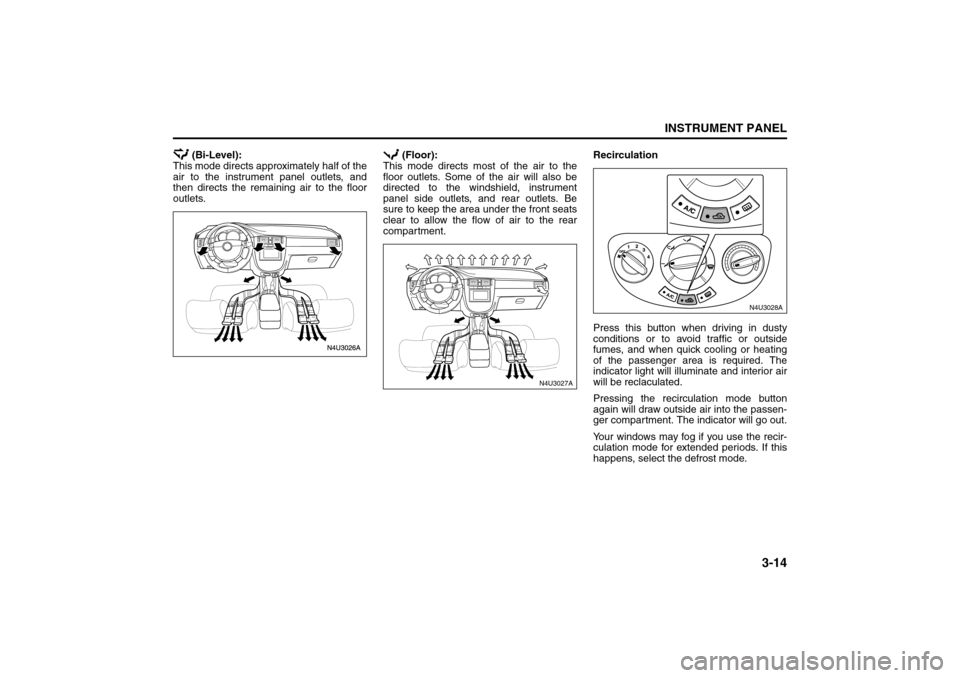
3-14
INSTRUMENT PANEL
85Z04-03E
(Bi-Level):
This mode directs approximately half of the
air to the instrument panel outlets, and
then directs the remaining air to the floor
outlets. (Floor):
This mode directs most of the air to the
floor outlets. Some of the air will also be
directed to the windshield, instrument
panel side outlets, and rear outlets. Be
sure to keep the area under the front seats
clear to allow the flow of air to the rear
compartment.Recirculation
Press this button when driving in dusty
conditions or to avoid traffic or outside
fumes, and when quick cooling or heating
of the passenger area is required. The
indicator light will illuminate and interior air
will be reclaculated.
Pressing the recirculation mode button
again will draw outside air into the passen-
ger compartment. The indicator will go out.
Your windows may fog if you use the recir-
culation mode for extended periods. If this
happens, select the defrost mode.
N4U3027AN4U3027A
N4U3028AN4U3028A
Climate Controls:
Page 136 of 226
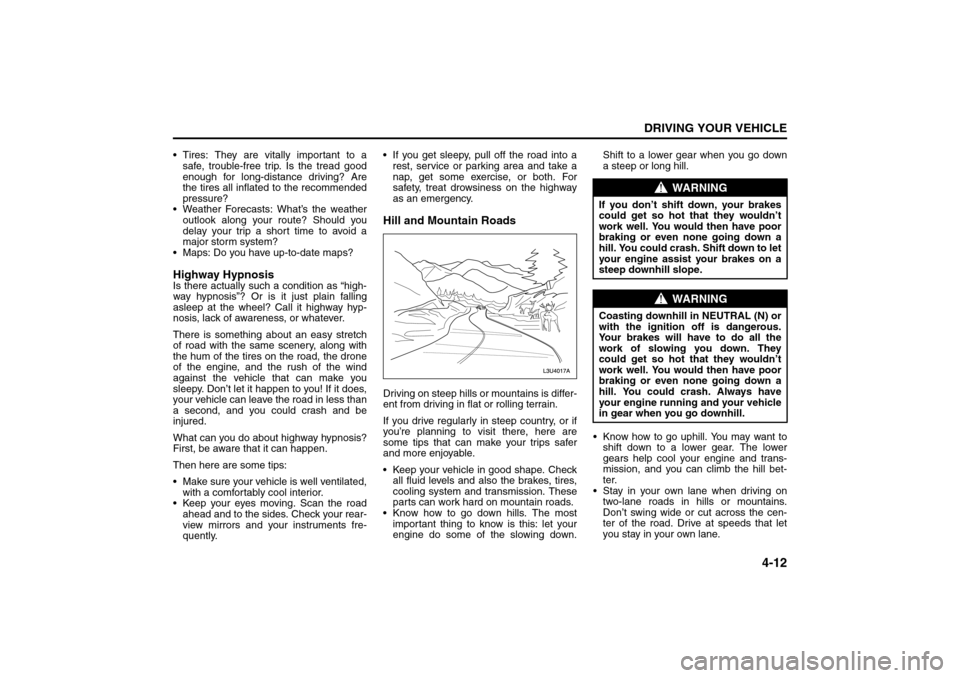
4-12
DRIVING YOUR VEHICLE
85Z04-03E
Tires: They are vitally important to a
safe, trouble-free trip. Is the tread good
enough for long-distance driving? Are
the tires all inflated to the recommended
pressure?
Weather Forecasts: What’s the weather
outlook along your route? Should you
delay your trip a short time to avoid a
major storm system?
Maps: Do you have up-to-date maps?Highway HypnosisIs there actually such a condition as “high-
way hypnosis”? Or is it just plain falling
asleep at the wheel? Call it highway hyp-
nosis, lack of awareness, or whatever.
There is something about an easy stretch
of road with the same scenery, along with
the hum of the tires on the road, the drone
of the engine, and the rush of the wind
against the vehicle that can make you
sleepy. Don’t let it happen to you! If it does,
your vehicle can leave the road in less than
a second, and you could crash and be
injured.
What can you do about highway hypnosis?
First, be aware that it can happen.
Then here are some tips:
Make sure your vehicle is well ventilated,
with a comfortably cool interior.
Keep your eyes moving. Scan the road
ahead and to the sides. Check your rear-
view mirrors and your instruments fre-
quently. If you get sleepy, pull off the road into a
rest, service or parking area and take a
nap, get some exercise, or both. For
safety, treat drowsiness on the highway
as an emergency.
Hill and Mountain RoadsDriving on steep hills or mountains is differ-
ent from driving in flat or rolling terrain.
If you drive regularly in steep country, or if
you’re planning to visit there, here are
some tips that can make your trips safer
and more enjoyable.
Keep your vehicle in good shape. Check
all fluid levels and also the brakes, tires,
cooling system and transmission. These
parts can work hard on mountain roads.
Know how to go down hills. The most
important thing to know is this: let your
engine do some of the slowing down.Shift to a lower gear when you go down
a steep or long hill.
Know how to go uphill. You may want to
shift down to a lower gear. The lower
gears help cool your engine and trans-
mission, and you can climb the hill bet-
ter.
Stay in your own lane when driving on
two-lane roads in hills or mountains.
Don’t swing wide or cut across the cen-
ter of the road. Drive at speeds that let
you stay in your own lane.
WARNING
If you don’t shift down, your brakes
could get so hot that they wouldn’t
work well. You would then have poor
braking or even none going down a
hill. You could crash. Shift down to let
your engine assist your brakes on a
steep downhill slope.
WARNING
Coasting downhill in NEUTRAL (N) or
with the ignition off is dangerous.
Your brakes will have to do all the
work of slowing you down. They
could get so hot that they wouldn’t
work well. You would then have poor
braking or even none going down a
hill. You could crash. Always have
your engine running and your vehicle
in gear when you go downhill.
Your Driving, the Road, and Your Vehicle:
Page 156 of 226
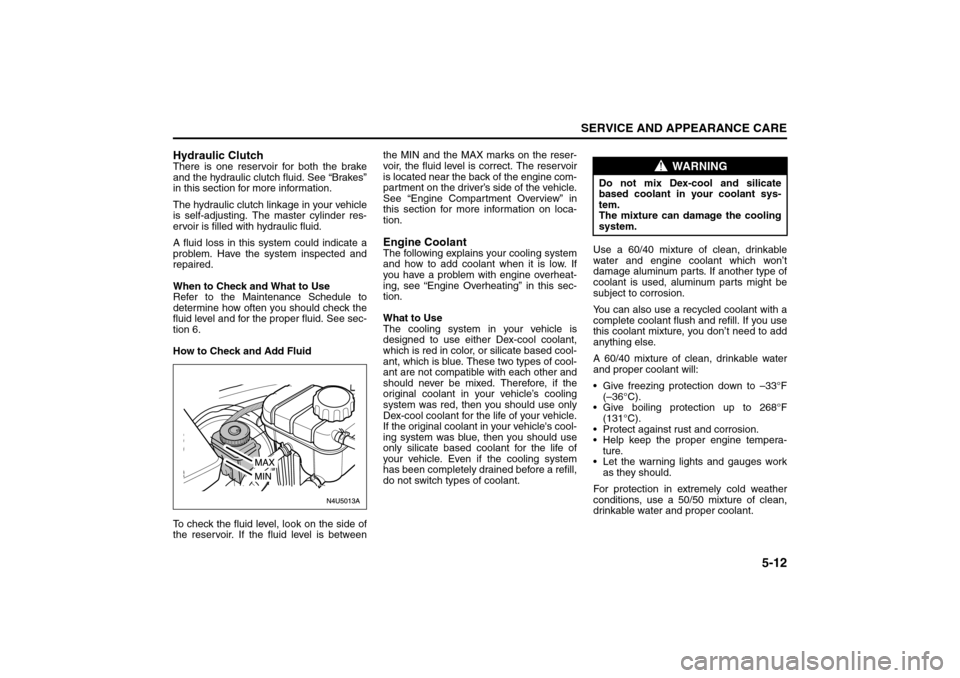
5-12
SERVICE AND APPEARANCE CARE
85Z04-03E
Hydraulic ClutchThere is one reservoir for both the brake
and the hydraulic clutch fluid. See “Brakes”
in this section for more information.
The hydraulic clutch linkage in your vehicle
is self-adjusting. The master cylinder res-
ervoir is filled with hydraulic fluid.
A fluid loss in this system could indicate a
problem. Have the system inspected and
repaired.
When to Check and What to Use
Refer to the Maintenance Schedule to
determine how often you should check the
fluid level and for the proper fluid. See sec-
tion 6.
How to Check and Add Fluid
To check the fluid level, look on the side of
the reservoir. If the fluid level is betweenthe MIN and the MAX marks on the reser-
voir, the fluid level is correct. The reservoir
is located near the back of the engine com-
partment on the driver’s side of the vehicle.
See “Engine Compartment Overview” in
this section for more information on loca-
tion.
Engine CoolantThe following explains your cooling system
and how to add coolant when it is low. If
you have a problem with engine overheat-
ing, see “Engine Overheating” in this sec-
tion.
What to Use
The cooling system in your vehicle is
designed to use either Dex-cool coolant,
which is red in color, or silicate based cool-
ant, which is blue. These two types of cool-
ant are not compatible with each other and
should never be mixed. Therefore, if the
original coolant in your vehicle’s cooling
system was red, then you should use only
Dex-cool coolant for the life of your vehicle.
If the original coolant in your vehicle's cool-
ing system was blue, then you should use
only silicate based coolant for the life of
your vehicle. Even if the cooling system
has been completely drained before a refill,
do not switch types of coolant.Use a 60/40 mixture of clean, drinkable
water and engine coolant which won’t
damage aluminum parts. If another type of
coolant is used, aluminum parts might be
subject to corrosion.
You can also use a recycled coolant with a
complete coolant flush and refill. If you use
this coolant mixture, you don’t need to add
anything else.
A 60/40 mixture of clean, drinkable water
and proper coolant will:
Give freezing protection down to –33°F
(–36°C).
Give boiling protection up to 268°F
(131°C).
Protect against rust and corrosion.
Help keep the proper engine tempera-
ture.
Let the warning lights and gauges work
as they should.
For protection in extremely cold weather
conditions, use a 50/50 mixture of clean,
drinkable water and proper coolant.
WARNING
Do not mix Dex-cool and silicate
based coolant in your coolant sys-
tem.
The mixture can damage the cooling
system.
Checking Things Under the Hood:
Page 157 of 226
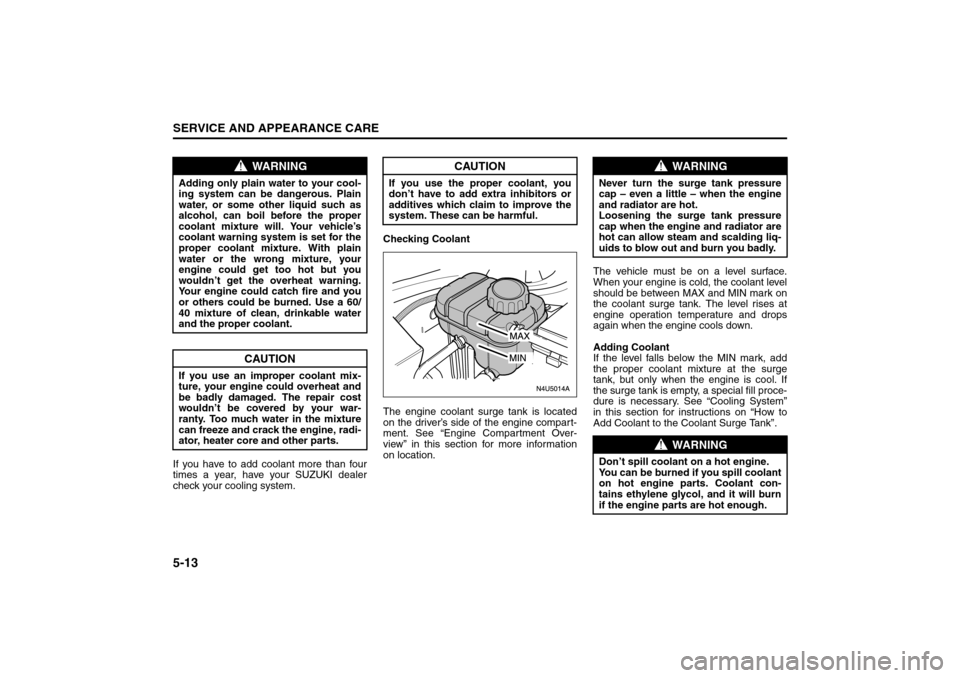
5-13SERVICE AND APPEARANCE CARE
85Z04-03E
If you have to add coolant more than four
times a year, have your SUZUKI dealer
check your cooling system.Checking Coolant
The engine coolant surge tank is located
on the driver’s side of the engine compart-
ment. See “Engine Compartment Over-
view” in this section for more information
on location.The vehicle must be on a level surface.
When your engine is cold, the coolant level
should be between MAX and MIN mark on
the coolant surge tank. The level rises at
engine operation temperature and drops
again when the engine cools down.
Adding Coolant
If the level falls below the MIN mark, add
the proper coolant mixture at the surge
tank, but only when the engine is cool. If
the surge tank is empty, a special fill proce-
dure is necessary. See “Cooling System”
in this section for instructions on “How to
Add Coolant to the Coolant Surge Tank”.
WARNING
Adding only plain water to your cool-
ing system can be dangerous. Plain
water, or some other liquid such as
alcohol, can boil before the proper
coolant mixture will. Your vehicle’s
coolant warning system is set for the
proper coolant mixture. With plain
water or the wrong mixture, your
engine could get too hot but you
wouldn’t get the overheat warning.
Your engine could catch fire and you
or others could be burned. Use a 60/
40 mixture of clean, drinkable water
and the proper coolant.
CAUTION
If you use an improper coolant mix-
ture, your engine could overheat and
be badly damaged. The repair cost
wouldn’t be covered by your war-
ranty. Too much water in the mixture
can freeze and crack the engine, radi-
ator, heater core and other parts.
CAUTION
If you use the proper coolant, you
don’t have to add extra inhibitors or
additives which claim to improve the
system. These can be harmful.
WARNING
Never turn the surge tank pressure
cap – even a little – when the engine
and radiator are hot.
Loosening the surge tank pressure
cap when the engine and radiator are
hot can allow steam and scalding liq-
uids to blow out and burn you badly.
WARNING
Don’t spill coolant on a hot engine.
You can be burned if you spill coolant
on hot engine parts. Coolant con-
tains ethylene glycol, and it will burn
if the engine parts are hot enough.
Checking Things Under the Hood:
Page 159 of 226
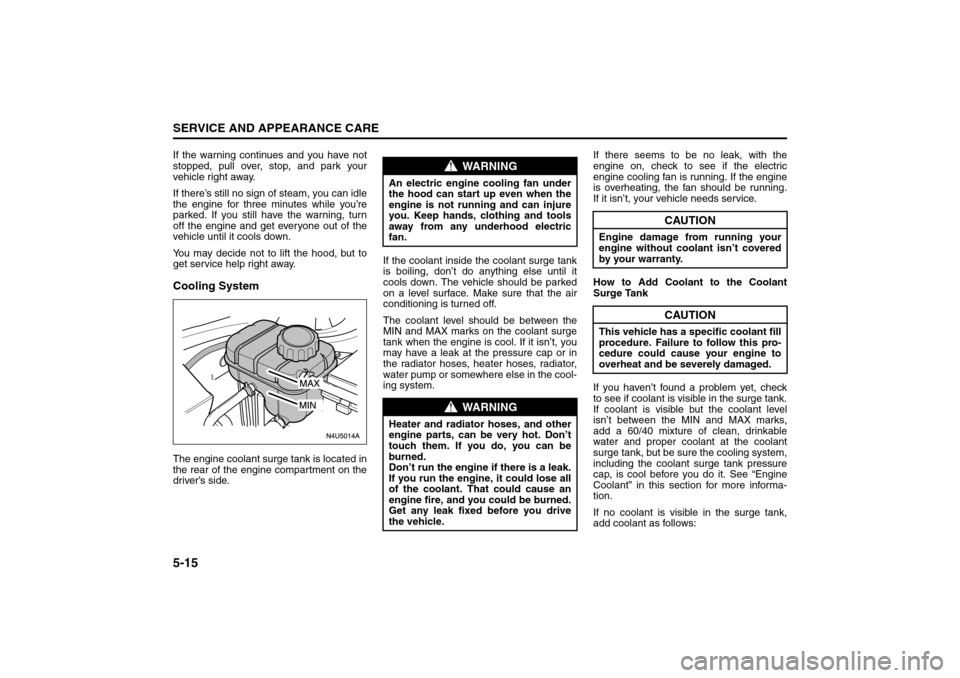
5-15SERVICE AND APPEARANCE CARE
85Z04-03E
If the warning continues and you have not
stopped, pull over, stop, and park your
vehicle right away.
If there’s still no sign of steam, you can idle
the engine for three minutes while you’re
parked. If you still have the warning, turn
off the engine and get everyone out of the
vehicle until it cools down.
You may decide not to lift the hood, but to
get service help right away.Cooling SystemThe engine coolant surge tank is located in
the rear of the engine compartment on the
driver’s side.If the coolant inside the coolant surge tank
is boiling, don’t do anything else until it
cools down. The vehicle should be parked
on a level surface. Make sure that the air
conditioning is turned off.
The coolant level should be between the
MIN and MAX marks on the coolant surge
tank when the engine is cool. If it isn’t, you
may have a leak at the pressure cap or in
the radiator hoses, heater hoses, radiator,
water pump or somewhere else in the cool-
ing system.If there seems to be no leak, with the
engine on, check to see if the electric
engine cooling fan is running. If the engine
is overheating, the fan should be running.
If it isn’t, your vehicle needs service.
How to Add Coolant to the Coolant
Surge Tank
If you haven’t found a problem yet, check
to see if coolant is visible in the surge tank.
If coolant is visible but the coolant level
isn’t between the MIN and MAX marks,
add a 60/40 mixture of clean, drinkable
water and proper coolant at the coolant
surge tank, but be sure the cooling system,
including the coolant surge tank pressure
cap, is cool before you do it. See “Engine
Coolant” in this section for more informa-
tion.
If no coolant is visible in the surge tank,
add coolant as follows:
WARNING
An electric engine cooling fan under
the hood can start up even when the
engine is not running and can injure
you. Keep hands, clothing and tools
away from any underhood electric
fan.
WARNING
Heater and radiator hoses, and other
engine parts, can be very hot. Don’t
touch them. If you do, you can be
burned.
Don’t run the engine if there is a leak.
If you run the engine, it could lose all
of the coolant. That could cause an
engine fire, and you could be burned.
Get any leak fixed before you drive
the vehicle.
CAUTION
Engine damage from running your
engine without coolant isn’t covered
by your warranty.
CAUTION
This vehicle has a specific coolant fill
procedure. Failure to follow this pro-
cedure could cause your engine to
overheat and be severely damaged.
Checking Things Under the Hood:
Page 160 of 226
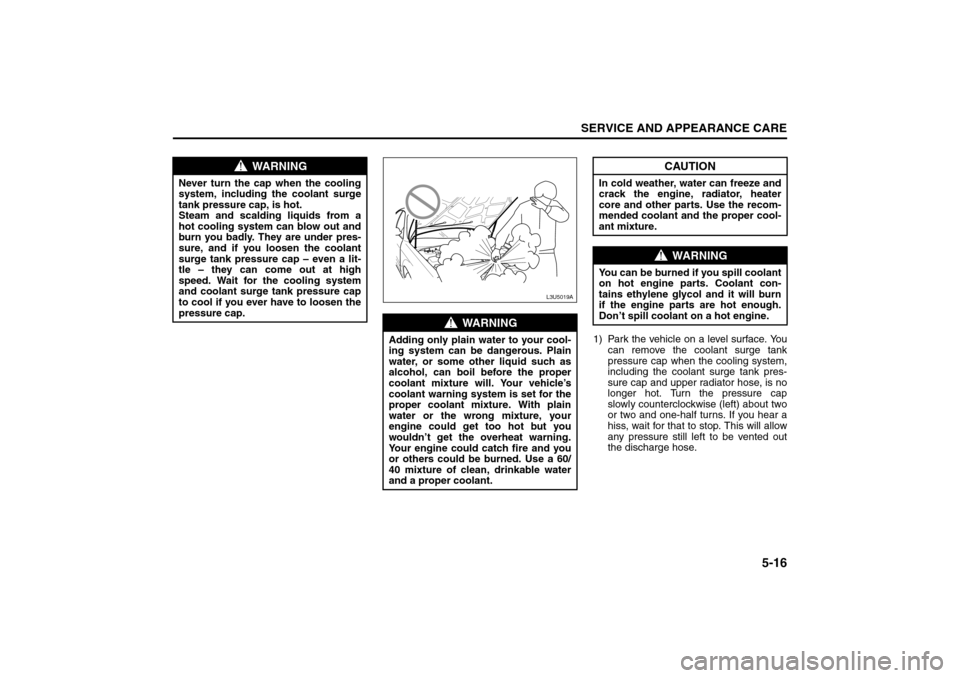
5-16
SERVICE AND APPEARANCE CARE
85Z04-03E
1) Park the vehicle on a level surface. You
can remove the coolant surge tank
pressure cap when the cooling system,
including the coolant surge tank pres-
sure cap and upper radiator hose, is no
longer hot. Turn the pressure cap
slowly counterclockwise (left) about two
or two and one-half turns. If you hear a
hiss, wait for that to stop. This will allow
any pressure still left to be vented out
the discharge hose.
WARNING
Never turn the cap when the cooling
system, including the coolant surge
tank pressure cap, is hot.
Steam and scalding liquids from a
hot cooling system can blow out and
burn you badly. They are under pres-
sure, and if you loosen the coolant
surge tank pressure cap – even a lit-
tle – they can come out at high
speed. Wait for the cooling system
and coolant surge tank pressure cap
to cool if you ever have to loosen the
pressure cap.
WARNING
Adding only plain water to your cool-
ing system can be dangerous. Plain
water, or some other liquid such as
alcohol, can boil before the proper
coolant mixture will. Your vehicle’s
coolant warning system is set for the
proper coolant mixture. With plain
water or the wrong mixture, your
engine could get too hot but you
wouldn’t get the overheat warning.
Your engine could catch fire and you
or others could be burned. Use a 60/
40 mixture of clean, drinkable water
and a proper coolant.
L3U5019A
CAUTION
In cold weather, water can freeze and
crack the engine, radiator, heater
core and other parts. Use the recom-
mended coolant and the proper cool-
ant mixture.
WARNING
You can be burned if you spill coolant
on hot engine parts. Coolant con-
tains ethylene glycol and it will burn
if the engine parts are hot enough.
Don’t spill coolant on a hot engine.
Checking Things Under the Hood: